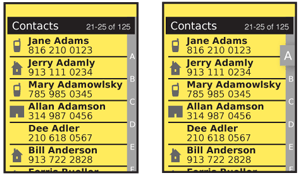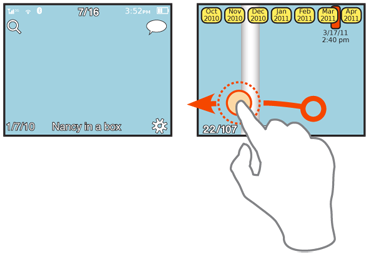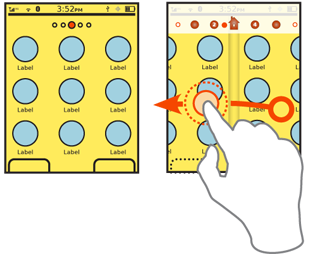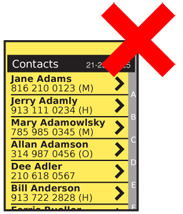|
Size: 8443
Comment:
|
Size: 8956
Comment:
|
| Deletions are marked like this. | Additions are marked like this. |
| Line 4: | Line 4: |
| '''Location Jump''' controls are typically custom-built to integrate with their host interactive methods. Good interactivity will require a certain level of graphic fidelity, so may not be suitable for some devices. | '''Location Jump''' controls are typically custom-built to integrate with their host interactive methods. Enough variations of this pattern exist to allow it to work on any device, but to be sure to choose one that works best with your display and input features, and standards of interaction. |
| Line 9: | Line 9: |
| The problem of accessing long lists of ordered data is not unique to interactive systems, and the solutions are directly related to the methods derived in the machine-era. The Rolodex (a portmanteau of "rolling index") is the prime example, a series of cards separated by tabbed label cards for letters of the alphabet. This might seem to be akin to the '''[[Tab]]''' pattern, but in fact the tabs are simply markers inline with the continuous list. | The problem of accessing long lists of ordered data is not unique to interactive systems, and the solutions are directly related to the methods derived in the machine-era. The Rolodex (a portmanteau of "rolling index") is the prime example, a series of cards separated by tabbed label cards for letters of the alphabet. This might seem to be akin to the '''[[Tab]]''' pattern, but the tabs here are different. Instead of providing access to different, parallel information sets, they are simply markers inline with the same, continuous list. |
| Line 15: | Line 17: |
| The '''[[Location Within]]''' pattern is very similar, but does not have interaction. | The '''[[Location Within]]''' pattern is very similar, but does not have interaction. '''[[Pagination]]''' is likewise similar, but page numbers are not an indexing method as they are unrelated to the content itself. |
| Line 21: | Line 23: |
| * Content indexing - The strict Rolodex style, with letters, numbers, or whatever other key indexing item in the list. Thumbnails generally do not work well. * General indicators - Most often dots, sometimes in varying quantities or sizes, but also icons and numbers. These are only really suitable for smaller sets, like '''[[Home & Idle Screens]]''' but there is much room to expand the pattern here. |
* '''Content indexing''' - The strict Rolodex style, with letters, numbers, or whatever other key indexing item in the list. Thumbnails generally do not work well. * '''General indicators''' - Most often dots, sometimes in varying quantities or sizes, but also icons and numbers. These are only really suitable for smaller sets, like '''[[Home & Idle Screens]]''' but there is much room to expand the pattern here. General indicators may seem to be not content-indexed, but are arranged in physical proximity or another manner to remind the user of the relationship so items may be found. |
| Line 24: | Line 26: |
| Each of these can also be interacted with in one of two key ways: * Direct selection - Click on the indicator label directly, or type it in. Press a P, and jump to the "P" section. * Drag selection - Drag an indicator of the current position, much like a scrollbar, to the position you want. |
You can also allow interaction with each of these in one of two key ways: * '''Direct selection''' - Click on the indicator label directly, or type it in. Press a P, and jump to the "P" section. * '''Drag selection''' - Drag an indicator of the current position, much like a scrollbar, to the position you want. |
| Line 33: | Line 35: |
| Direct selection, or scrolling within the list, is very straightforward when touch or pen interfaces are used. Virtual cursors and 5-way pads do not work well with this pattern. | Direct selection, or scrolling within the list, is very straightforward when touch or pen interfaces are used. Virtual cursors and 5-way '''[[Directional Entry]]''' pads do not work well with this pattern. |
| Line 35: | Line 37: |
| Scroll-and-select interfaces do not often use this pattern. They may take advantage of it by using '''[[Accesskeys]]''' for the input method. This works best when the input method corresponds to the indexing method. A 10-key device will present difficulties with alpha input, though methods have been devised, such as clustering and using numeric keys to jump to sections. More often, the '''[[Search Within]]''' pattern is used for the actual keypad input, even if a '''Location Jump''' like '''[[[Position Within]]]''' indicator is also presented. | Scroll-and-select interfaces may instead take advantage of it by using '''[[Accesskeys]]''' for the input method. This works best when the input method corresponds to the indexing method. A 10-key device will present difficulties with alpha input, though methods have been devised, such as clustering and using numeric keys to jump to sections. More often, the '''[[Search Within]]''' pattern is used for the actual keypad input, even if a '''Location Jump''' like '''[[[Position Within]]]''' indicator is also presented. |
| Line 37: | Line 39: |
| For '''[[Vertical List]]''' displays, any scroll bar must generally be removed, in favor of the '''Location Jump''' indicator complex. Any use of other scroll methods, such as gestural scroll or hardware keys must work in concert with this pattern, and indicate changes immediately. | For '''[[Vertical List]]''' displays, you must usually remove any scrollbar, in favor of the '''Location Jump''' indicator complex. Any use of other scroll methods, such as gestural scroll or hardware keys must work in concert with this pattern, and indicate changes immediately. |
Problem
Scrolling to items in a long vertical list is cumbersome. You must be sure to design an indexing system to assist in retrieval, and to design a method to allow easy access to key indexed portions of the list.
Location Jump controls are typically custom-built to integrate with their host interactive methods. Enough variations of this pattern exist to allow it to work on any device, but to be sure to choose one that works best with your display and input features, and standards of interaction.

Solution
The problem of accessing long lists of ordered data is not unique to interactive systems, and the solutions are directly related to the methods derived in the machine-era. The Rolodex (a portmanteau of "rolling index") is the prime example, a series of cards separated by tabbed label cards for letters of the alphabet.
This might seem to be akin to the Tab pattern, but the tabs here are different. Instead of providing access to different, parallel information sets, they are simply markers inline with the same, continuous list.
The variation on this, the flat Autodex with a single list of letters and a sliding control to select the section is even more directly what is copied into digital Location Jump systems. An indicator of location, or indexing system, is visible on the screen and this may be used to jump to the front of an indexed section.
These are used with the Vertical List pattern, but could be used in other types of displays as well. Specifically, the Location Within pattern used on [Filmstrip] like Home & Idle Screens can be interactive instead.
The Location Within pattern is very similar, but does not have interaction. Pagination is likewise similar, but page numbers are not an indexing method as they are unrelated to the content itself.

Variations
There are two key sets of variations. The first is in display:
Content indexing - The strict Rolodex style, with letters, numbers, or whatever other key indexing item in the list. Thumbnails generally do not work well.
General indicators - Most often dots, sometimes in varying quantities or sizes, but also icons and numbers. These are only really suitable for smaller sets, like Home & Idle Screens but there is much room to expand the pattern here. General indicators may seem to be not content-indexed, but are arranged in physical proximity or another manner to remind the user of the relationship so items may be found.
You can also allow interaction with each of these in one of two key ways:
Direct selection - Click on the indicator label directly, or type it in. Press a P, and jump to the "P" section.
Drag selection - Drag an indicator of the current position, much like a scrollbar, to the position you want.
Of course, both of these can be used together. And other methods can also be used to move the list, such as simple Scroll.

Interaction Details
Direct selection, or scrolling within the list, is very straightforward when touch or pen interfaces are used. Virtual cursors and 5-way Directional Entry pads do not work well with this pattern.
Scroll-and-select interfaces may instead take advantage of it by using Accesskeys for the input method. This works best when the input method corresponds to the indexing method. A 10-key device will present difficulties with alpha input, though methods have been devised, such as clustering and using numeric keys to jump to sections. More often, the Search Within pattern is used for the actual keypad input, even if a Location Jump like [Position Within] indicator is also presented.
For Vertical List displays, you must usually remove any scrollbar, in favor of the Location Jump indicator complex. Any use of other scroll methods, such as gestural scroll or hardware keys must work in concert with this pattern, and indicate changes immediately.
Presentation Details
The indicator, whether a symbol, or an index value like a letter, will be stored in a strip (which may not be opaque) along the axis of movement of the list. A vertical list will have a vertical strip. Generally, this should be on the lowest-use side, so the right side for vertical lists.
The key problem with this pattern is making the widget large enough to be visible, or to be selected, without using too much screen space or distracting the user from the primary task.
The general solution is to always present the indicator, but very small (with the characters as much as half the conventional minimum size). As soon as any action occurs relating to item finding -- such as scrolling, direct input via keypad or on-screen gestures to that edge -- the indicator strip will expand to a viewable and selectable size.
An alternative is to have only the currently in-focus portion expand to the larger size, if scrolling instead of direct selection is the access method. For all scrolling-only interfaces, the index item currently in focus should be approximately in the center of the screen. At the ends of the list, this may be odd looking, and it may be to the natural side instead.
When a position is selected by scrolling the Location Jump widget, the list itself must live scroll, although this may be simulated by blurring much of the data if the distance to be scrolled is very large. When jumping to a new position by direct selection of an index feature, scroll to the new position to indicate the change.
If the distance is very long, simulate a scroll by accelerating, then jumping closer, then decelerating to the location. The jump may be obscured with a brief motion blur as well. The total transition should only take 0.5-1 sec, but the transition helps a great deal in understanding that the action was carried out. One part of a list is very much the same as another, so a change may not be noticed if an instant jump occurs.
The current position in the position indicator must always be communciated. Anything clear will do, from highlight, to bold to an indicator bar or other icon in the bar. This must also animate live when scrolling or jumping to a new position.

Antipatterns
Do not jump to a new position, in any scroll method. Always indicate that the new position in the list was scrolled to by showing the scrolling action to the new position in the list.
Do not allow indicators to disappear during scrolling and other movement. They must also transition live whenever possible.
Use caution when placing items within a list. Do not allow critical labels to disappear under the position indicator. On touch devices, keep buttons and other interactive items away from the Location Jump controls side of the list.
Discuss & Add
Please do not change content above this line, as it's a perfect match with the printed book. Everything else you want to add goes down here.
Examples
If you want to add examples (and we occasionally do also) add them here.
Make a new section
Just like this. If, for example, you want to argue about the differences between, say, Tidwell's Vertical Stack, and our general concept of the List, then add a section to discuss. If we're successful, we'll get to make a new edition and will take all these discussions into account.
